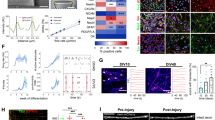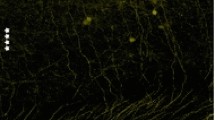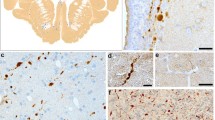Abstract
To examine the time course and relative extent of proteolysis of neurofilament and tubulin proteins after traumatic axonal injury (TAI), anesthetized mice were subjected to optic nerve stretch injury. Immunohistochemistry confirmed neurofilament accumulation within axonal swellings at 4, 24, and 72 h postinjury (n = 4 injured and 2 sham per time point). Immunoblotting of optic nerve homogenates (n = 5 injured and 1 sham at 0.5, 4, 24 or 72 h) revealed calpain-mediated spectrin proteolytic fragments after injury. Protein levels for NF68 progressively decreased from 0.5 h to 24 h postinjury, while NF200 and α-tubulin levels decreased acutely (0.5–4 h), with a secondary decline at 72 h postinjury. These data demonstrate that diffusely distributed TAI is associated not only with a localized accumulation of neurofilament proteins, but also significant decreases in total cytoskeletal protein levels which may be mediated, in part, by calpains. Protection of the axonal cytoskeleton represents a potential therapeutic target for axonal damage associated with injury or neurodegenerative diseases.





Similar content being viewed by others
References
Adams JH, Graham DI, Gennarelli TA (1983) Head injury in man and experimental animals: neuropathology. Acta Neurochir Suppl (Wien) 32:15–30
Gentleman SM, Roberts GW, Gennarelli TA, Maxwell WL, Adams JH et al (1995) Axonal injury: a universal consequence of fatal closed head injury? Acta Neuropathol (Berl) 89:537–543
Adams JH, Doyle D, Ford I, Gennarelli TA, Graham DI, McLellan DR (1989) Diffuse axonal injury in head injury: definition, diagnosis and grading. Histopathology 15:49–59
Pettus EH, Christman CW, Giebel ML, Povlishock JT (1994) Traumatically induced altered membrane permeability: its relationship to traumatically induced reactive axonal change. J Neurotrauma 11:507–522
Gennarelli TA (1996) The spectrum of traumatic axonal injury. Neuropathol Appl Neurobiol 22:509–513
Pettus EH, Povlishock JT (1996) Characterization of a distinct set of intra-axonal ultrastructural changes associated with traumatically induced alteration in axolemmal permeability. Brain Res 722:1–11
Saatman KE, Graham DI, McIntosh TK (1998) The neuronal cytoskeleton is at risk after mild and moderate brain injury. J Neurotrauma 15:1047–1058
Raghupathi R, Mehr MF, Helfaer MA, Margulies SS (2004) Traumatic axonal injury is exacerbated following repetitive closed head injury in the neonatal pig. J Neurotrauma 21:307–316
Povlishock JT, Becker DP, Cheng CL, Vaughan GW (1983) Axonal change in minor head injury. J Neuropathol Exp Neurol 42:225–242
Saatman KE, Serbest G, Burkhardt MF (2007) Axonal damage due to traumatic brain injury. In: Lajtha A (ed) Handbook of neurochemistry and molecular neurobiology. Plenum Publishers
Hoffman PN, Griffin JW, Price DL (1984) Control of axonal caliber by neurofilament transport. J Cell Biol 99:705–714
Schlaepfer WW (1987) Neurofilaments: structure, metabolism and implications in disease. J Neuropathol Exp Neurol 46:117–129
Stephens RE, Edds KT (1976) Microtubules: structure, chemistry, and function. Physiol Rev 56:709–777
Schnapp BJ, Vale RD, Sheetz MP, Reese TS (1985) Single microtubules from squid axoplasm support bidirectional movement of organelles. Cell 40:455–462
Grady MS, McLaughlin MR, Christman CW, Valadka AB, Fligner CL, Povlishock JT (1993) The use of antibodies targeted against the neurofilament subunits for the detection of diffuse axonal injury in humans. J Neuropathol Exp Neurol 52:143–152
Yaghmai A, Povlishock J (1992) Traumatically induced reactive change as visualized through the use of monoclonal antibodies targeted to neurofilament subunits. J Neuropathol Exp Neurol 51:158–176
Chen XH, Meaney DF, Xu BN, Nonaka M, McIntosh TK et al (1999) Evolution of neurofilament subtype accumulation in axons following diffuse brain injury in the pig. J Neuropathol Exp Neurol 58:588–596
Saatman KE, Abai B, Grosvenor A, Vorwerk CK, Smith DH, Meaney DF (2003) Traumatic axonal injury results in biphasic calpain activation and retrograde transport impairment in mice. J Cereb Blood Flow Metab 23:34–42
McCracken E, Hunter AJ, Patel S, Graham DI, Dewar D (1999) Calpain activation and cytoskeletal protein breakdown in the corpus callosum of head-injured patients. J Neurotrauma 16:749–761
Okonkwo DO, Pettus EH, Moroi J, Povlishock JT (1998) Alteration of the neurofilament sidearm and its relation to neurofilament compaction occurring with traumatic axonal injury. Brain Res 784:1–6
Maxwell WL, Domleo A, McColl G, Jafari SS, Graham DI (2003) Post-acute alterations in the axonal cytoskeleton after traumatic axonal injury. J Neurotrauma 20:151–168
Jafari SS, Maxwell WL, Neilson M, Graham DI (1997) Axonal cytoskeletal changes after non-disruptive axonal injury. J Neurocytol 26:207–221
Maxwell WL, Graham DI (1997) Loss of axonal microtubules and neurofilaments after stretch-injury to guinea pig optic nerve fibers. J Neurotrauma 14:603–614
Buki A, Povlishock JT (2006) All roads lead to disconnection?—Traumatic axonal injury revisited. Acta Neurochir (Wien) 148:181–193
Kampfl A, Posmantur RM, Zhao X, Schmutzhard E, Clifton GL, Hayes RL (1997) Mechanisms of calpain proteolysis following traumatic brain injury: implications for pathology and therapy: a review and update. J Neurotrauma 14:121–134
Ray SK, Hogan EL, Banik NL (2003) Calpain in the pathophysiology of spinal cord injury: neuroprotection with calpain inhibitors. Brain Res Brain Res Rev 42:169–185
Johnson GV, Litersky JM, Jope RS (1991) Degradation of microtubule-associated protein 2 and brain spectrin by calpain: a comparative study. J Neurochem 56:1630–1638
Roberts-Lewis JM, Savage MJ, Marcy VR, Pinsker LR, Siman R (1994) Immunolocalization of calpain I-mediated spectrin degradation to vulnerable neurons in the ischemic gerbil brain. J Neurosci 14:3934–3944
Saatman KE, Bozyczko-Coyne D, Marcy V, Siman R, McIntosh TK (1996) Prolonged calpain-mediated spectrin breakdown occurs regionally following experimental brain injury in the rat. J Neuropathol Exp Neurol 55:850–860
Banik NL, Matzelle DC, Gantt-Wilford G, Osborne A, Hogan EL (1997) Increased calpain content and progressive degradation of neurofilament protein in spinal cord injury. Brain Res 752:301–306
Posmantur RM, Zhao X, Kampfl A, Clifton GL, Hayes RL (1998) Immunoblot analyses of the relative contributions of cysteine and aspartic proteases to neurofilament breakdown products following experimental brain injury in rats. Neurochem Res 23:1265–1276
Ray SK, Shields DC, Saido TC, Matzelle DC, Wilford GG et al (1999) Calpain activity and translational expression increased in spinal cord injury. Brain Res 816:375–380
Newcomb JK, Kampfl A, Posmantur RM, Zhao X, Pike BR et al (1997) Immunohistochemical study of calpain-mediated breakdown products to alpha-spectrin following controlled cortical impact injury in the rat. J Neurotrauma 14:369–383
Springer JE, Azbill RD, Kennedy SE, George J, Geddes JW (1997) Rapid calpain I activation and cytoskeletal protein degradation following traumatic spinal cord injury: attenuation with riluzole pretreatment. J Neurochem 69:1592–1600
Schumacher PA, Eubanks JH, Fehlings MG (1999) Increased calpain I-mediated proteolysis, and preferential loss of dephosphorylated NF200, following traumatic spinal cord injury. Neuroscience 91:733–744
Buki A, Siman R, Trojanowski JQ, Povlishock JT (1999) The role of calpain-mediated spectrin proteolysis in traumatically induced axonal injury. J Neuropathol Exp Neurol 58:365–375
Singleton RH, Zhu J, Stone JR, Povlishock JT (2002) Traumatically induced axotomy adjacent to the soma does not result in acute neuronal death. J Neurosci 22:791–802
Cheng CL, Povlishock JT (1988) The effect of traumatic brain injury on the visual system: a morphologic characterization of reactive axonal change. J Neurotrauma 5:47–60
Gennarelli TA, Thibault LE, Tipperman R, Tomei G, Sergot R et al (1989) Axonal injury in the optic nerve: a model simulating diffuse axonal injury in the brain. J Neurosurg 71:244–253
Meaney DF, Ross DT, Winkelstein BA, Brasko J, Goldstein D et al (1994) Modification of the cortical impact model to produce axonal injury in the rat cerebral cortex. J Neurotrauma 11:599–612
Hamberger A, Huang YL, Zhu H, Bao F, Ding M et al (2003) Redistribution of neurofilaments and accumulation of beta-amyloid protein after brain injury by rotational acceleration of the head. J Neurotrauma 20:169–178
Jafari SS, Nielson M, Graham DI, Maxwell WL (1998) Axonal cytoskeletal changes after nondisruptive axonal injury. II Intermediate sized axons. J Neurotrauma 15:955–966
Posmantur R, Hayes RL, Dixon CE, Taft WC (1994) Neurofilament 68 and neurofilament 200 protein levels decrease after traumatic brain injury. J Neurotrauma 11:533–545
Posmantur R, Kampfl A, Siman R, Liu J, Zhao X et al (1997) A calpain inhibitor attenuates cortical cytoskeletal protein loss after experimental traumatic brain injury in the rat. Neuroscience 77:875–888
Kupina NC, Detloff MR, Dutta S, Hall ED (2002) Neuroimmunophilin ligand V-10,367 is neuroprotective after 24-h delayed administration in a mouse model of diffuse traumatic brain injury. J Cereb Blood Flow Metab 22:1212–1221
Park E, Liu E, Shek M, Park A, Baker AJ (2007) Heavy neurofilament accumulation and alpha-spectrin degradation accompany cerebellar white matter functional deficits following forebrain fluid percussion injury. Exp Neurol 204:49–57
Greenwood JA, Troncoso JC, Costello AC, Johnson GV (1993) Phosphorylation modulates calpain-mediated proteolysis and calmodulin binding of the 200-kDa and 160-kDa neurofilament proteins. J Neurochem 61:191–199
Maxwell WL, Povlishock JT, Graham DL (1997) A mechanistic analysis of nondisruptive axonal injury: a review. J Neurotrauma 14:419–440
Moskowitz PF, Smith R, Pickett J, Frankfurter A, Oblinger MM (1993) Expression of the class III beta-tubulin gene during axonal regeneration of rat dorsal root ganglion neurons. J Neurosci Res 34:129–134
Fournier AE, McKerracher L (1995) Tubulin expression and axonal transport in injured and regenerating neurons in the adult mammalian central nervous system. Biochem Cell Biol 73:659–664
Taft WC, Yang K, Dixon CE, Hayes RL (1992) Microtubule-associated protein 2 levels decrease in hippocampus following traumatic brain injury. J Neurotrauma 9:281–290
Haranishi Y, Kawata R, Fukuda S, Kiyoshima T, Morimoto Y et al (2005) Moderate hypothermia, but not calpain inhibitor 2, attenuates the proteolysis of microtubule-associated protein 2 in the hippocampus following traumatic brain injury in rats. Eur J Anaesthesiol 22:140–147
Zhang SX, Underwood M, Landfield A, Huang FF, Gison S, Geddes JW (2000) Cytoskeletal disruption following contusion injury to the rat spinal cord. J Neuropathol Exp Neurol 59:287–296
Geddes JW, Bondada V, Tekirian TL, Pang Z, Siman RG (1995) Perikaryal accumulation and proteolysis of neurofilament proteins in the post-mortem rat brain. Neurobiol Aging 16:651–660
Irving EA, McCulloch J, Dewar D (1997) The effect of postmortem delay on the distribution of microtubule-associated proteins tau, MAP2, and MAP5 in the rat. Mol Chem Neuropathol 30:253–271
Schwab C, Bondada V, Sparks DL, Cahan LD, Geddes JW (1994) Postmortem changes in the levels and localization of microtubule-associated proteins (tau, MAP2 and MAP1B) in the rat and human hippocampus. Hippocampus 4:210–225
Schumacher PA, Siman RG, Fehlings MG (2000) Pretreatment with calpain inhibitor CEP-4143 inhibits calpain I activation and cytoskeletal degradation, improves neurological function, and enhances axonal survival after traumatic spinal cord injury. J Neurochem 74:1646–1655
Buki A, Farkas O, Doczi T, Povlishock JT (2003) Preinjury administration of the calpain inhibitor MDL-28170 attenuates traumatically induced axonal injury. J Neurotrauma 20:261–268
Zhang SX, Bondada V, Geddes JW (2003) Evaluation of conditions for calpain inhibition in the rat spinal cord: effective postinjury inhibition with intraspinal MDL28170 microinjection. J Neurotrauma 20:59–67
Ray SK, Matzelle DC, Wilford GG, Hogan EL, Banik NL (2000) E-64-d prevents both calpain upregulation and apoptosis in the lesion and penumbra following spinal cord injury in rats. Brain Res. 867:80–89
Buki A, Okonkwo DO, Wang KK, Povlishock JT (2000) Cytochrome c release and caspase activation in traumatic axonal injury. J Neurosci 20:2825–2834
Nixon RA, Marotta CA (1984) Degradation of neurofilament proteins by purified human brain cathepsin D. J Neurochem 43:507–516
Banay-Schwartz M, Bracco F, DeGuzman T, Lajtha A (1983) Developmental changes in the breakdown of brain tubulin by cerebral cathepsin D. Neurochem Res 8:51–61
Banay-Schwartz M, Dahl D, Hui KS, Lajtha A (1987) The breakdown of the individual neurofilament proteins by cathepsin D. Neurochem Res 12:361–367
Ellis RC, Earnhardt JN, Hayes RL, Wang KK, Anderson DK (2004) Cathepsin B mRNA and protein expression following contusion spinal cord injury in rats. J Neurochem 88:689–697
Banik NL, Hogan EL, Powers JM, Smith KP (1986) Proteolytic enzymes in experimental spinal cord injury. J Neurol Sci 73:245–256
Acknowledgments
This study was supported, in part, by NIH P50-NS08803, R01-NS45131, R01-NS41561 and T32-NS043126. We would like to thank Dr. Juan Wang for assistance with immunoblotting and Heather N. Foozer for assistance with manuscript preparation.
Author information
Authors and Affiliations
Corresponding author
Additional information
Special issue in honor of Naren Banik.
Rights and permissions
About this article
Cite this article
Serbest, G., Burkhardt, M.F., Siman, R. et al. Temporal Profiles of Cytoskeletal Protein Loss following Traumatic Axonal Injury in Mice. Neurochem Res 32, 2006–2014 (2007). https://doi.org/10.1007/s11064-007-9318-9
Received:
Accepted:
Published:
Issue Date:
DOI: https://doi.org/10.1007/s11064-007-9318-9




